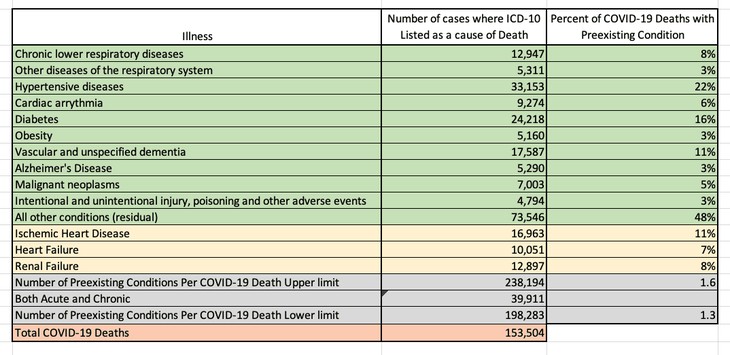Over the last two days, there has been quite an uproar over the CDC’s statement that only 6% of COVID-19 deaths were as a result of the virus alone. The following statement on the agency’s website caused confusion and debate:
Table 3 shows the types of health conditions and contributing causes mentioned in conjunction with deaths involving coronavirus disease 2019 (COVID-19). For 6% of the deaths, COVID-19 was the only cause mentioned. For deaths with conditions or causes in addition to COVID-19, on average, there were 2.6 additional conditions or causes per death. The number of deaths with each condition or cause is shown for all deaths and by age groups.
For readers who have followed news on the pandemic closely, the number made sense. We have been told for months that those with the highest risk of dying from the virus are elderly with preexisting conditions. This would indicate that very few healthy individuals die from the virus. Six percent would seem like a logical number for deaths attributed to COVID-19 alone.
However, after further research, I found that the death certificate data is actually cataloging comorbidities. These are the illnesses that are the primary and proximate causes of an individual’s death. A comorbid condition is not always a preexisting condition. For example, a patient may develop adult respiratory distress syndrome in late-state COVID-19. Both may be listed on the death certificate.
Likewise, a person may have late-stage cancer. They may then catch COVID-19. The cancer is obviously a preexisting condition not caused by COIVD-19, however, both may be listed on the death certificate. Both of these situations were reflected in the mortality data.
OH THE HORROR! Sturgis Motorcycle Rally COVID-19 Numbers Are in and They Are Shocking
Those deaths coded as COVID-19 alone may be the result of lazy documentation or an assumption that the comorbidities caused by the virus are not relevant. Ultimately everyone dies of cardiac arrest, for example, however, this is rarely listed as a cause of death other than in acute heart conditions such as a massive heart attack.
The CDC statement was poorly worded and caused confusion across the media landscape and for the public. After downloading the entire data file, I was able to estimate the number of deaths in people with preexisting conditions.
Deaths are coded using ICD-10 codes. These are the same codes used for medical billing and can be viewed online. After eliminating the codes that are typical diagnoses caused by COVID-19, such as respiratory failure, the following data remains.

These calculations based on preexisting conditions are in the ballpark, but they are not perfect. The reason a range has to be calculated is that the illnesses in yellow can be either acute, and caused by COVID-19, or chronic. Because the chronic forms are prevalent in the elderly, I calculated the rate both ways. The death certificate data puts the ICD-10 codes for acute and chronic illnesses on the same line.
Those shaded in green are ICD-10 codes that are not caused by COVID-19. The line “All other conditions and causes (residual)” contains hundreds of ICD-10 codes. Because the codes include illnesses such as HIV, autoimmune disorders, blood disorders, and other diseases of the immune system, it was placed in the category of always preexisting conditions.
The calculation also keeps the deaths listed as solely COVID-19 in the analysis because that diagnosis only reflects a positive test or presumed COVID-19. The number of cases coded this way was 9,210, or 6% of total deaths. The range may be lower than actuals since it is unlikely there were no other proximate causes in these cases. They are just not listed.
With these assumptions, individuals who die with or of COVID-19 have 1.3 to 1.5 preexisting conditions on average. A more robust analysis could be done if a file with a line for each death, with specific ICD-10 codes for the causes, was made public. That is the file that would show how many deaths were attributed to COVID-19 and the illnesses it causes. The deaths with preexisting conditions would also be easily identified.
FINALLY: The CDC Publishes COVID-19 Testing Guidance That Makes Sense
The average number of preexisting conditions would be included in the average of 2.6 comorbidities per death initially calculated by the CDC. Unfortunately, the data is not as rich and detailed as it could be. A detailed and accurate analysis of what preexisting conditions are fatal in the case of a COVID-19 infection would be helpful to individuals in assessing their own risk and taking proper precautions.
The “all other conditions” category is too broad. This analysis attributes these illnesses as a preexisting condition in nearly half of all cases. Many ICD-10 codes in the class are neither common nor fatal. Insight into the risks to individuals with HIV, autoimmune diseases, blood disorders, and immunosuppression would be informative.
Reframing the data is probably more helpful in understanding what it actually says about healthy people dying of COVID-19. This update does not change the assessment that many COVID-19 deaths could be ones that would have occurred in the near term even without the virus. This analysis was in my original article on the CDC statement. To assess the real impact of the virus on the population, evaluating excess deaths over time is the correct metric.










Join the conversation as a VIP Member